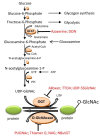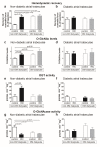The Role of O-GlcNAcylation for Protection against Ischemia-Reperfusion Injury
- PMID: 30669312
- PMCID: PMC6359045
- DOI: 10.3390/ijms20020404
The Role of O-GlcNAcylation for Protection against Ischemia-Reperfusion Injury
Abstract
Ischemia reperfusion injury (IR injury) associated with ischemic heart disease contributes significantly to morbidity and mortality. O-linked β-N-acetylglucosamine (O-GlcNAc) is a dynamic posttranslational modification that plays an important role in numerous biological processes, both in normal cell functions and disease. O-GlcNAc increases in response to stress. This increase mediates stress tolerance and cell survival, and is protective. Increasing O-GlcNAc is protective against IR injury. Experimental cellular and animal models, and also human studies, have demonstrated that protection against IR injury by ischemic preconditioning, and the more clinically applicable remote ischemic preconditioning, is associated with increases in O-GlcNAc levels. In this review we discuss how the principal mechanisms underlying tissue protection against IR injury and the associated immediate elevation of O-GlcNAc may involve attenuation of calcium overload, attenuation of mitochondrial permeability transition pore opening, reduction of endoplasmic reticulum stress, modification of inflammatory and heat shock responses, and interference with established cardioprotective pathways. O-GlcNAcylation seems to be an inherent adaptive cytoprotective response to IR injury that is activated by mechanical conditioning strategies.
Keywords: O-GlcNAc; cardioprotection; ischemia-reperfusion injury.
Conflict of interest statement
The authors declare no conflict of interest.
Figures



References
-
- Burns R.J., Gibbons R.J., Yi Q., Roberts R.S., Miller T.D., Schaer G.L., Anderson J.L., Yusuf S. The relationships of left ventricular ejection fraction, end-systolic volume index and infarct size to six-month mortality after hospital discharge following myocardial infarction treated by thrombolysis. J. Am. Coll. Cardiol. 2002;39:30–36. doi: 10.1016/S0735-1097(01)01711-9. - DOI - PubMed
-
- Andersen H.R., Nielsen T.T., Rasmussen K., Thuesen L., Kelbaek H., Thayssen P., Abildgaard U., Pedersen F., Madsen J.K., Grande P., et al. A comparison of coronary angioplasty with fibrinolytic therapy in acute myocardial infarction. N. Engl. J. Med. 2003;349:733–742. doi: 10.1056/NEJMoa025142. - DOI - PubMed
-
- World Health Organisation. [(accessed on 1 November 2018)]; Available online: http://www.who.int/mediacentre/factsheets/fs317/en/
Publication types
MeSH terms
Substances
Grants and funding
LinkOut - more resources
Full Text Sources

